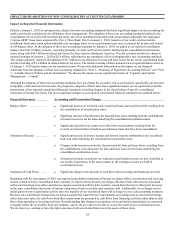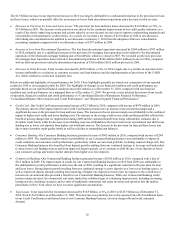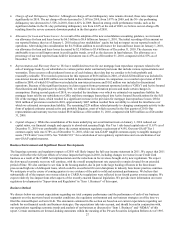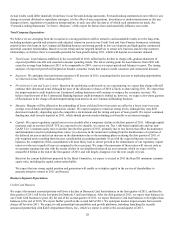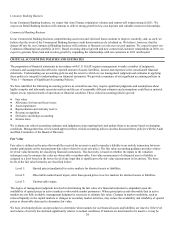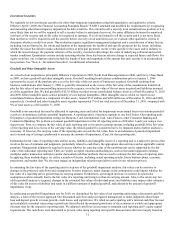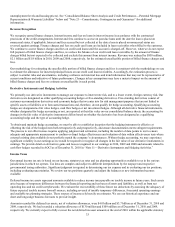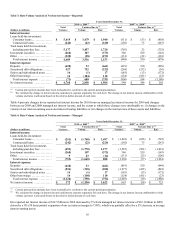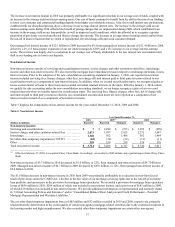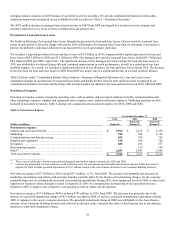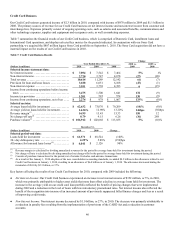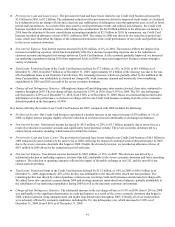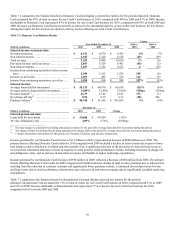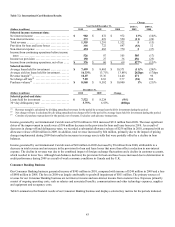Capital One 2010 Annual Report Download - page 53
Download and view the complete annual report
Please find page 53 of the 2010 Capital One annual report below. You can navigate through the pages in the report by either clicking on the pages listed below, or by using the keyword search tool below to find specific information within the annual report.33
unemployment levels and housing prices). See “Consolidated Balance Sheet Analysis and Credit Performance—Potential Mortgage
Representation & Warranty Liabilities” below and “Note 21—Commitments, Contingencies and Guarantees” for additional
information.
Revenue Recognition
We recognize earned finance charges, interest income and fees on loans in interest income in accordance with the contractual
provisions of the credit arrangements. Interest and fees continue to accrue on past due loans until the date the loan is placed on
nonaccrual status, if applicable. Interest and fees accrued but not collected at the date a loan is placed on nonaccrual status are
reversed against earnings. Finance charges and fees on credit card loans are included in loan receivables when billed to the customer.
We continue to accrue finance charges and fees on credit card loans until the account is charged-off. However, when we do not expect
full payment of billed finance charges and fees, we reduce the balance of our credit card loan receivables by the amount of finance
charges billed but not expected to be collected and exclude this amount from interest income. Revenue was reduced by $950 million,
$2.1 billion and $1.9 billion in 2010, 2009 and 2008, respectively, for the estimated uncollectible portion of billed finance charges and
fees.
Our methodology for estimating the uncollectible portion of billed finance charges and fees is consistent with the methodology we use
to estimate the allowance for incurred principal losses on our credit card loan receivables. Accordingly, the estimation process is
subject to similar risks and uncertainties, including a reliance on historical loss and trend information that may not be representative of
current conditions and indicative of future performance. Changes in key assumptions may have a material impact on the amount of
billed finance charges and fees we estimate as uncollectible in each period.
Derivative Instruments and Hedging Activities
We primarily use derivative instruments to manage our exposure to interest rate risk, and to a lesser extent, foreign currency risk. Our
derivatives are designated as either qualifying accounting hedges or free-standing derivatives. Free-standing derivatives consist of
customer-accommodation derivatives and economic hedges that we enter into for risk management purposes that are not linked to
specific assets or liabilities or to forecasted transactions and, therefore, do not qualify for hedge accounting. Qualifying accounting
hedges are designated as fair value hedges, cash flow hedges or net investment hedges. Although all derivative financial instruments,
whether designated for hedge accounting or not, are reported at their fair value on our consolidated balance sheets, the accounting for
changes in the fair value of derivative instruments differs based on whether the derivative has been designated as a qualifying
accounting hedge and the type of accounting hedge.
To obtain and maintain hedge accounting, we must be able to establish at inception that the hedging instrument is effective at
offsetting the risk of the hedged item both retrospectively and prospectively, and ensure documentation meets stringent requirements.
The process to test effectiveness requires applying judgment and estimation, including the number of data points to test to ensure
adequate and appropriate measurement to confirm or dispel hedge effectiveness and valuation of data within effectiveness tests where
external existing data available do not perfectly match the company’s circumstances. Without hedge accounting, we may experience
significant volatility in our earnings as we would be required to recognize all changes in the fair value of our derivative instruments in
earnings. We provide detail on derivatives gains and losses recognized in our earnings in 2010, 2009 and 2008 and amounts related to
cash flow hedges recorded in AOCI as of December 31, 2010 in “Note 11—Derivative Instruments and Hedging Activities.”
Income Taxes
Our annual income tax rate is based on our income, statutory tax rates and tax planning opportunities available to us in the various
jurisdictions in which we operate. Tax laws are complex and subject to different interpretations by the taxpayer and respective
governmental taxing authorities. Significant judgment is required in determining our tax expense and in evaluating our tax positions,
including evaluating uncertainties. We review our tax positions quarterly and adjust the balances as new information becomes
available.
Deferred income tax assets represent amounts available to reduce income taxes payable on taxable income in future years. Such assets
arise because of temporary differences between the financial reporting and tax bases of assets and liabilities, as well as from net
operating loss and tax credit carryforwards. We evaluate the recoverability of these future tax deductions by assessing the adequacy of
future expected taxable income from all sources, including reversal of taxable temporary differences, forecasted operating earnings
and available tax planning strategies. These sources of income rely heavily on estimates. We use our historical experience and our
short and long-range business forecasts to provide insight.
Amounts recorded for deferred tax assets, net of valuation allowances, were $4.0 billion and $3.7 billion as of December 31, 2010 and
2009, respectively. We had recorded a valuation allowance of $130 million and $109 million as of December 31, 2010 and 2009,
respectively. We currently expect to fully recover the net deferred tax asset amounts at the end of 2010 within the applicable statutory



